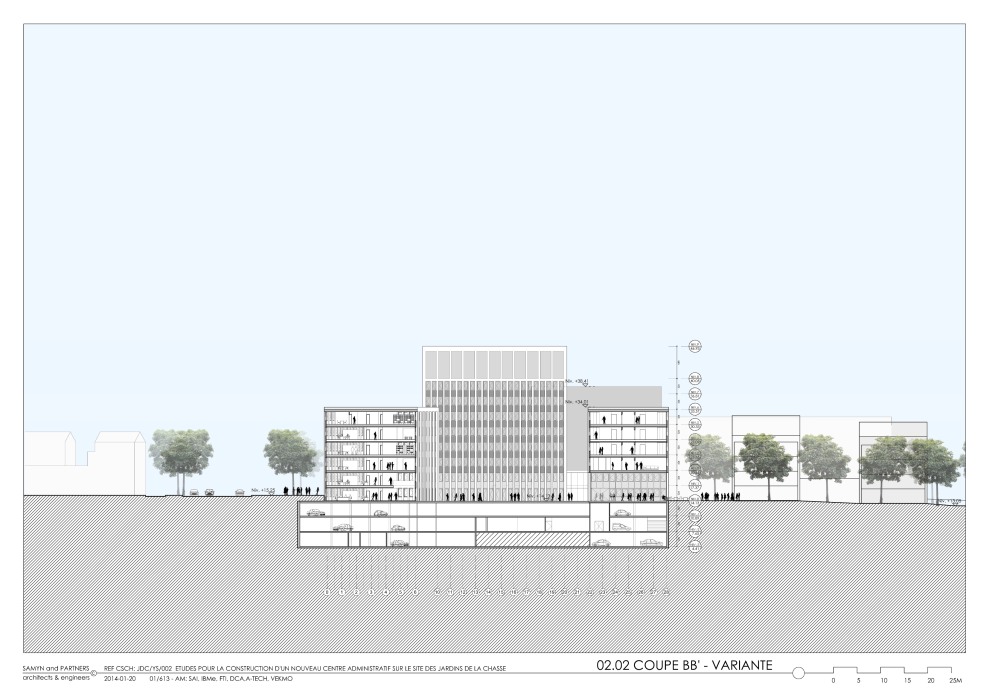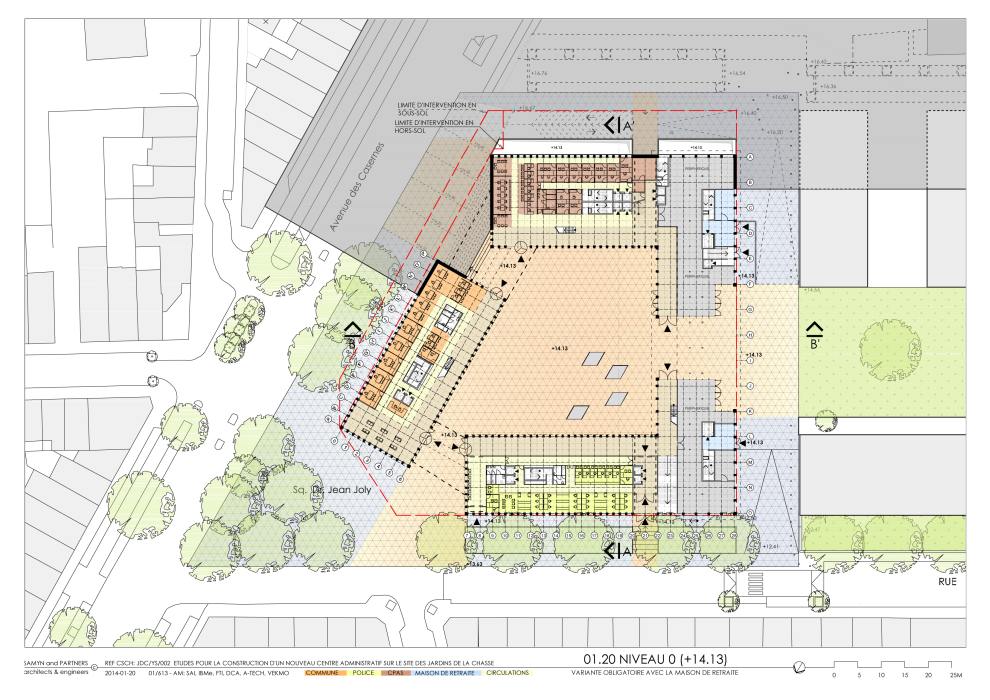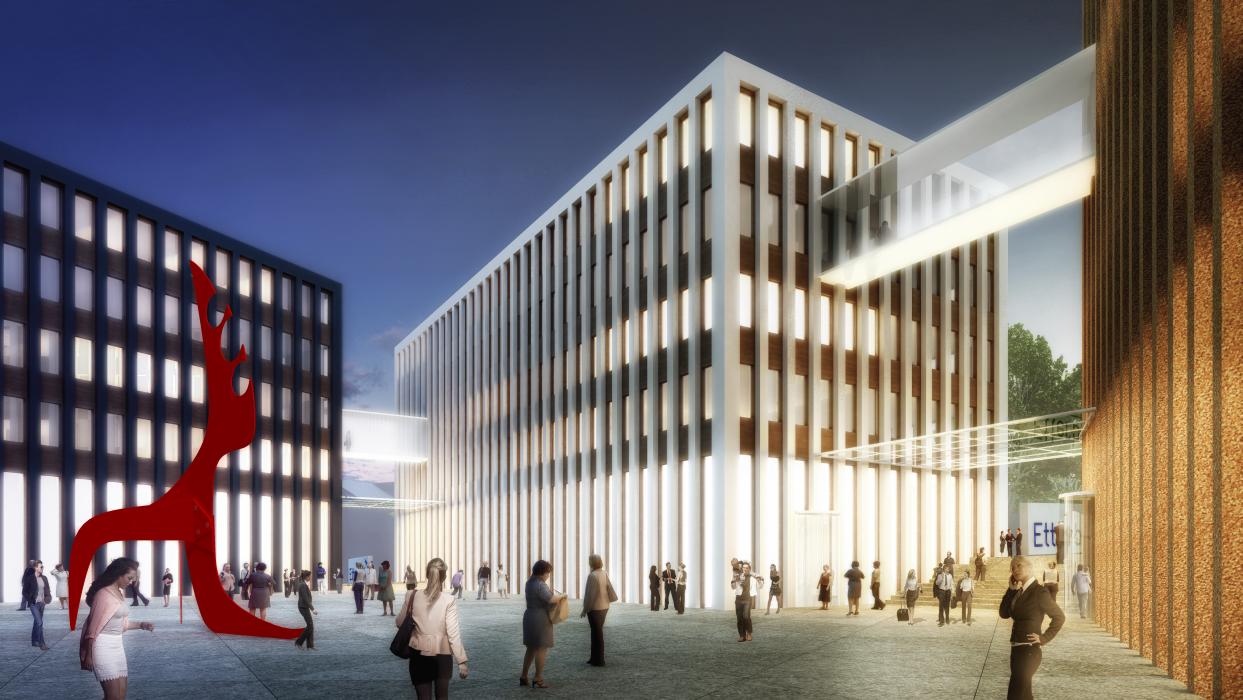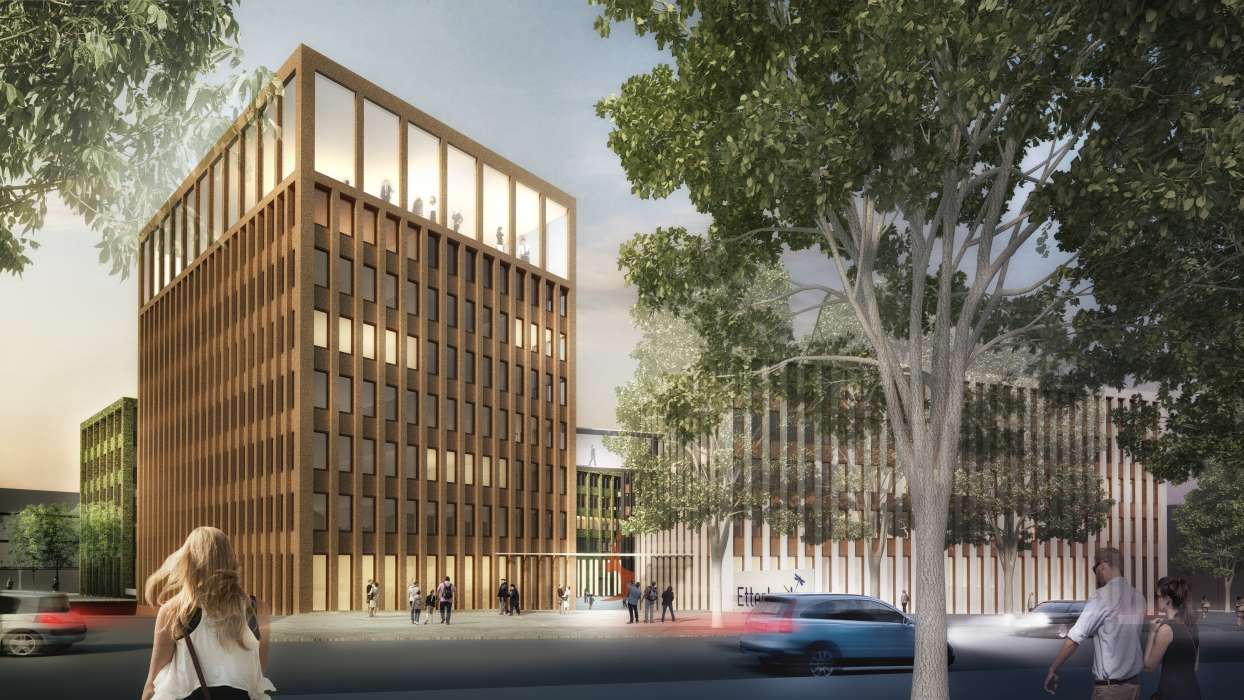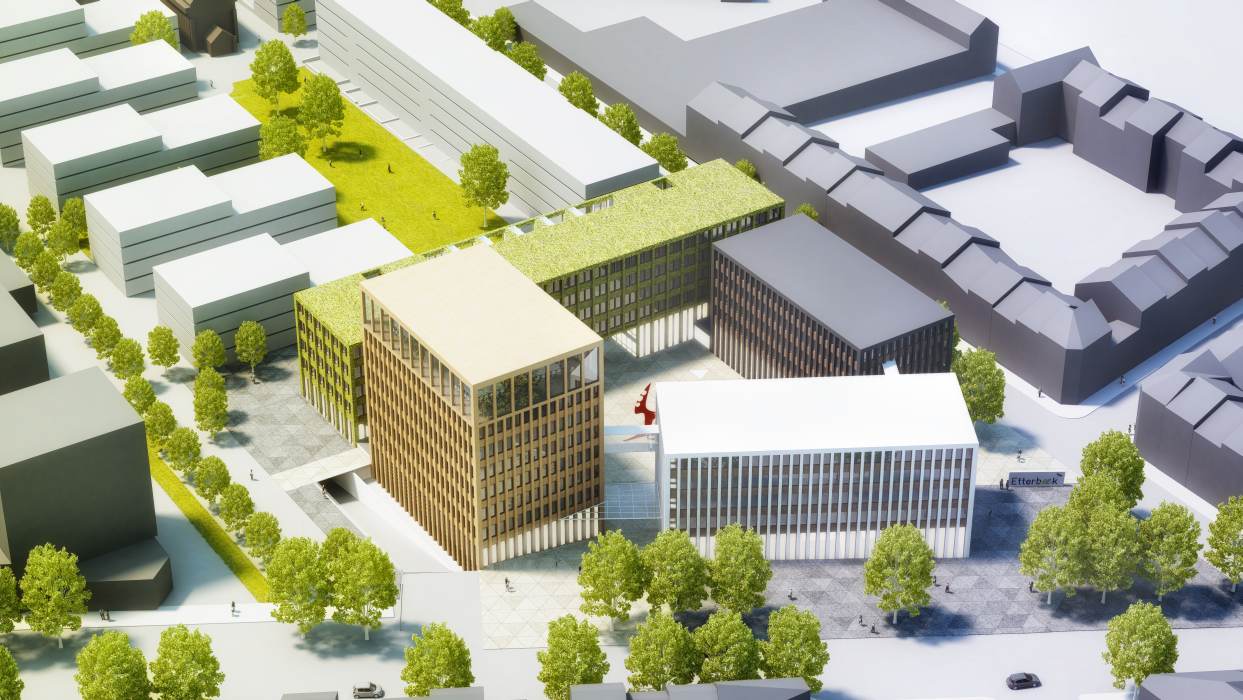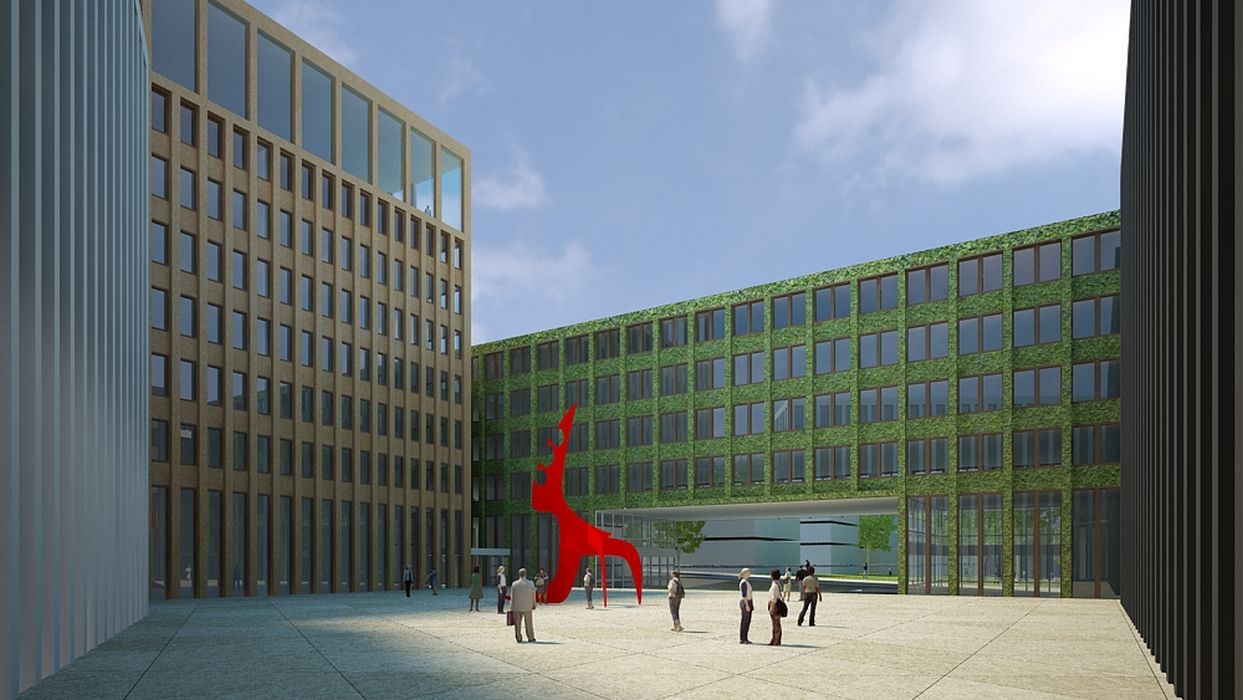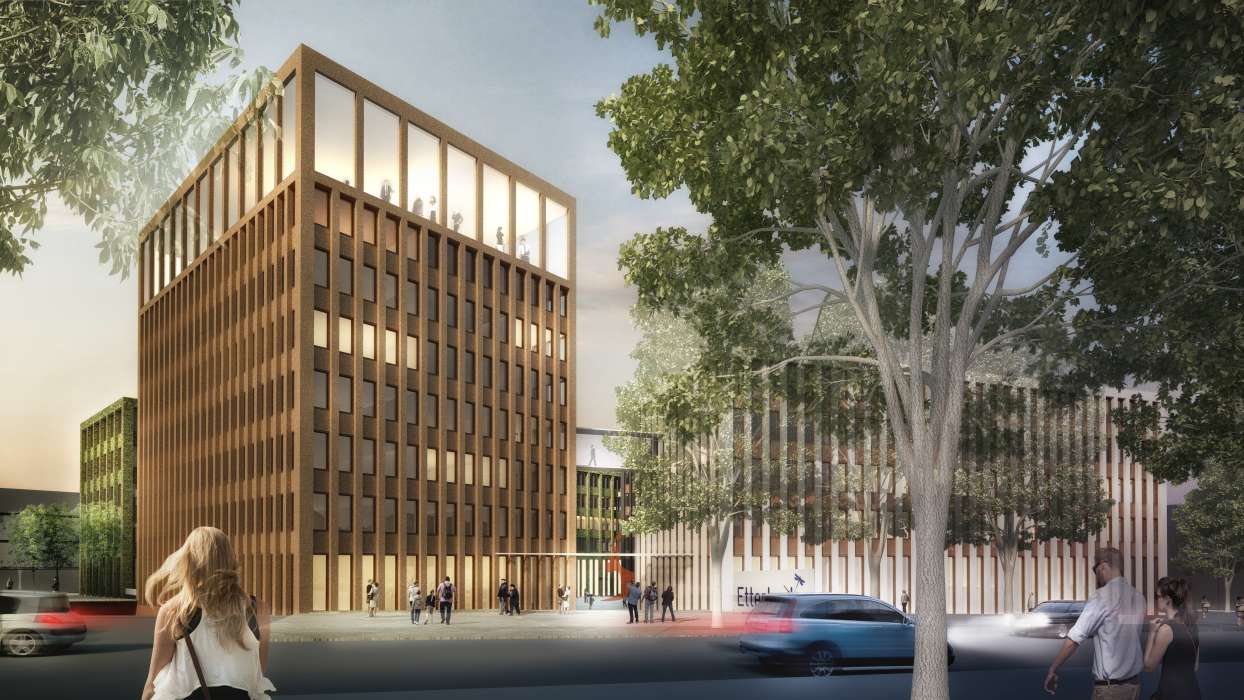
613 – ETTERBEEK ADMINISTRATIVE CENTRE
‘Jardins de la Chasse’ site, Etterbeek, Brussels, Belgium
50°49’42.33″ N, 4°23’25.353″ E
20,000 m² above ground and 16,000 m² underground; 2013-2014; (01/613).
Competition by invitation.
- Landscaping
- Architecture
- Interior design
- Structural engineering
- Building services engineering
- Building physics
- Acoustics
- Project management
- Cost control
- Health and safety coordination
Urban landscape
The project is aimed at creating a “village”, a district of the city organised around a central square, rather than a closed monolithic block.This square opens onto the present (and future) urban environment via a large number of passages. These are positioned at the openings left between the spaces on the district’s pedestrian walkways. The generously sized square (40 m wide, 30 to 60 m deep) becomes a new cohesive place protected from a new urban centralisation.
Municipal Office House, Public Social Welfare Centre (CPAS), Police services and Housing: these four key functions are arranged in four different spaces around the square in keeping with the surrounding urban street-lines. The colours of their facade cladding are also differentiated (weathering steel for the tallest tower, white architectural concrete and dark grey zinc for the other two blocks), expressing the variety of services offered to citizens and the concern for inclusion in a multi-faceted urban environment. The similarity of the building outlines, on the other hand, shows the unitary and integral nature of the entire complex. The housing layout is clearly distinguished from other functions by a green and red covering of climbing plants (Virginia creeper). The council chamber sits atop the entire complex like a lantern facing the city. On the ground floor, a glass and interior gallery, extending over two levels, surrounds the central square and connects the different spaces into a cohesive functional and urban whole, in the style of squares enclosed by arcades.
This gallery allows people to reach all the Administrative Centre’s public services. As a continuation of the central square and the large hall at the northern entrance of the white block, it forms a huge reception area where numerous events are possible (exhibitions, fairs, readings,…). Providing a single city-wide entrance to the Administrative Centre, the central square can host a variety of temporary events (markets, flea markets, street performances, tent events…).
The approaches to the Administrative Centre are regarded as a vibrant urban continuum.
Extended along the avenue des Casernes to the south entrance, Jean Joly Square becomes a huge forecourt facing north and northeast that allows access to the new district. It is an urban space in its own right where urban life can develop in relation to the avenue des Casernes.
Rue des Stones and the ‘Jardins de la Chasse’ park form another square facing southwest. This features the main facade of the apartments, their entrances, a restaurant with a terrace and a wide passage leading to the central square. The transparency between the square and the park is achieved by this wide passage open on two levels and by the transparency of the restaurant and the functions surrounding the passage. The green landscaping of the housing space contributes to the green continuum linking the park, the central square and the avenue des Casernes.
Efficiency and functional dynamics – Equipment durability and flexibility
A regular 1.35 m framework structures the layout of all office and parking areas, while imparting rhythm to all the facades. This modular layout of plan and facade systems offers a high degree of flexibility in interior design and surface use.
The floors are arranged in a highly compact and space-efficient manner.
Some floors are arranged as duplex structures to facilitate vertical inter-department relationships.
Walkways between areas link the different entities and provide them with a high degree of flexibility in the breakdown of functions according to present and future needs.
The Administrative Centre is divided into blocks to create reasonably sized floors where natural light enters from four sides. It also allows for the real estate to be divided up effortlessly in due course: for example, the sale or rental of part of the Administrative Centre, or the reconstruction of part of the Centre without disrupting the operation of the rest (the “Layer model” principle).
Above a window breast at the height of the work surface, the facade is glazed up to the ceiling so that natural light can penetrate as far as possible into the building interior. The glass sections cover 70% of the facade surface, striking a good balance between natural light, heat loss and summer overheating.
It is simple to clean the glass parts from the inside, as all the windows are operable.
A lamellar sun-break protection system reduces the solar gain during the summer period while allowing a view of the outside.
A removable elevated floor enables the clean air supply to pass through, as well as all the other building equipment (electricity, data, shade wiring…).
Reinforced concrete floors whose underside remains visible are heat fed to form what is called an “active floor”. Sound baffles deliver the necessary sound damping.
Passive Objective and NZEB
In compliance with the European EPBD Directive on the energy performance of buildings, the project is designed to meet not only the ‘passive’ requirement but also the NZEB (Nearly Zero Energy Building) criterion.
The following principles and equipment are established to achieve this objective: heat exchange between offices and homes in the district; possible use of cogeneration producing electricity for offices and heat for homes simultaneously; centralised production of heat and cooling to take maximum advantage of the scale effect; geothermal energy; heat pump; condensing auxiliary boiler; hot/cold convectors supporting active slabs; harnessing the inertia of structural concrete; solar photovoltaic panels; solar thermal panels producing domestic hot water; dual-flow ventilation with high-efficiency heat recovery wheel.
Materials
The facade materials are chosen in the light of their solidity, their low maintenance requirements and their durability: weathering steel, zinc and fluorinated architectural concrete.
The frames and window breasts are made of timber, which is chosen to exploit its specific heat qualities while contrasting with the mineral surfaces. It is protected by bulk-processing (retification via heat treatment).
The interior materials are selected after an analysis of their ranking in the Dutch NIBE reference system and the British “Green Guide to Specification”.
Philippe SAMYN and PARTNERS All projects are designed by Philippe Samyn who also supervises every drawing
Philippe SAMYN and PARTNERS with SETESCO (sister company (1986-2006) or INGENIEURSBUREAU MEIJER (sister company 2007-2015) if not mentioned
Philippe SAMYN and PARTNERS with FTI (sister company since 1989) if not mentioned
For plans sections and elevations, please refer to the archives section of the site available from the “references” menu.

